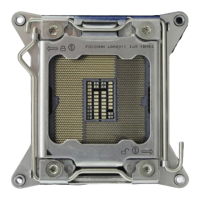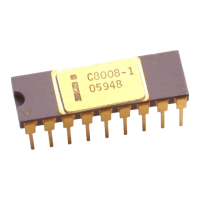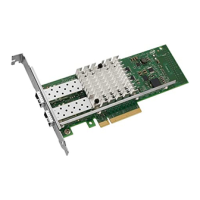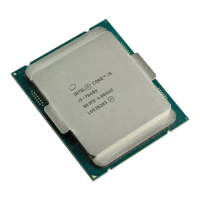Intel® Xeon™ Processor with 800 MHz System Bus
34 Datasheet
3.2 Processor Component Keepout Zones
The processor may contain components on the substrate that define component keepout zone
requirements. A thermal and mechanical solution design must not intrude into the required keepout
zones. Decoupling capacitors are typically mounted to either the topside or pin-side of the package
substrate. See Figure 8 for keepout zones.
3.3 Package Loading Specifications
Table 17 provides dynamic and static load specifications for the processor package. These
mechanical load limits should not be exceeded during heatsink assembly, mechanical stress testing
or standard drop and shipping conditions. The heatsink attach solutions must not include
continuous stress onto the processor with the exception of a uniform load to maintain the heatsink-
to-processor thermal interface. Also, any mechanical system or component testing should not
exceed these limits. The processor package substrate should not be used as a mechanical reference
or load-bearing surface for thermal or mechanical solutions.
NOTES:
1. These specifications apply to uniform compressive loading in a direction perpendicular to the IHS top
surface.
2. This is the minimum and maximum static force that can be applied by the heatsink and retention solution to
maintain the heatsink and processor interface.
3. These specifications are based on limited testing for design characterization. Loading limits are for the
package only and do not include the limits of the processor socket.
4. This specification applies for thermal retention solutions that allow baseboard deflection.
5. This specification applies either for thermal retention solutions that prevent baseboard deflection or for the
Intel enabled reference solution (CEK).
6. Dynamic loading is defined as an 11 ms duration average load superimposed on the static load requirement.
7. Experimentally validated test condition used a heatsink mass of 1 lbm (~0.45 kg) with 100 G acceleration
measured at heatsink mass. The dynamic portion of this specification in the product application can have
flexibility in specific values, but the ultimate product of mass times acceleration should not exceed this
validated dynamic load (1 lbm x 100 G = 100 lb). Allowable strain in the dynamic compressive load
specification is in addition to the strain allowed in static loading.
8. Transient loading is defined as a 2 second duration peak load superimposed on the static load requirement,
representative of loads experienced by the package during heatsink installation.
Table 17. Processor Loading Specifications
Parameter Min Max Unit Notes
Static
Compressive Load
44
10
222
50
N
lbf
1,2,3,4
44
10
288
65
N
lbf
1,2,3,5
Dynamic
Compressive Load
NA
NA
222 N + 0.45 kg *100 G
50 lbf (static) + 1 lbm * 100 G
N
lbf
1,3,4,6,7
NA
NA
288 N + 0.45 kg * 100 G
65 lbf (static) + 1 lbm * 100 G
N
lbf
1,3,5,6,7
Transient NA 445
100
N
lbf
1,3,8
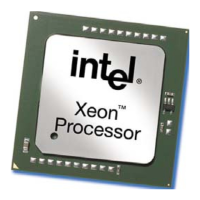
